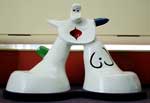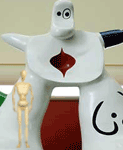VAM galleries including this work:
The Kentucky Center | What’s in a Name? | Young at Art || VAM Home
Joan Miró (Spanish, 1893-1983)
PERSONNAGE, 1972
Resin over a steel armature, painted with polyurethane; 188" X 135" X 63"
Gift of Betty and David Jones and Wendell Cherry
The Kentucky Center for the Performing Arts
This massive sculpture stands more than 15 feet tall. Despite its bottom-heavy stability, the two-sided Personnage possesses an odd equilibrium. Its ballooning and receding convexities and concavities suggest a number of visual puns on the male and female forms. Underlying the humor of this piece is Miró’s sense of wonderment and reverence for all kinds of life, real and imaginary.
About the Artist
Joan Miró was born in Barcelona, Spain, in 1893. Although he began art lessons at the age of 7 and studied through his teens, Miró eventually attended business school in hopes of obtaining more traditional employment. It wasn’t until he suffered a nervous breakdown that Miró returned to art, studying at the Barcelona School of Fine Arts and the Academia Gali.
The early influences on Miró’s work were the Fauves, Cubism, Catalan folk art, and the Romanesque church frescoes of his homeland. But after moving to Paris in 1920, he met the Surrealist poets and writers. Their ideas resonated with his own work, which was already heading in the direction of fantasy art, and he joined the Surrealist group in 1924. Surrealism’s emphasis on the irrational and on the importance of dreams prompted Miró to use childhood memories as inspiration for his art. Throughout his career, he worked and experimented with a number of different media and artistic processes, including printmaking, painting, collage, and sculpture.
Classroom Ideas
Discussion: Describe Personnage. How has Miró used the elements of art in this piece? Research the Surrealist movement in art. Does this work fit the definition of Surrealism? Why or why not? Use specific details that reference the artwork in your response.
Compare Miró’s sculpture to some of his paintings. Do they look similar? Why or why not?
Activity: Miró used dreams and childhood memories as inspiration for his art. With whimsical freedom, he created a world of creatures whose bulbous shapes seem to have a cartoon-like potential for constant change. In the medium of your choice, quickly draw, paint, or sculpt from clay or another substance a fantasy figure from a childhood memory or dream.
Links
You’ll find a biography, works, and more at the Miró Foundation web site.
[www.bcn.fjmiro.es]
For more online resources, look up Joan Miró in the Artcyclopedia or the Artchive.
[www.artcyclopedia.com/artists/miro_joan.html]
[www.artchive.com/artchive/M/miro.html]
Lesson plans exploring Miró can be found at Enchanted Learning and at the Kennedy Center’s ArtsEdge site.
[www.enchantedlearning.com/artists/miro/]
[artsedge.kennedy-center.org/content/2005/]

